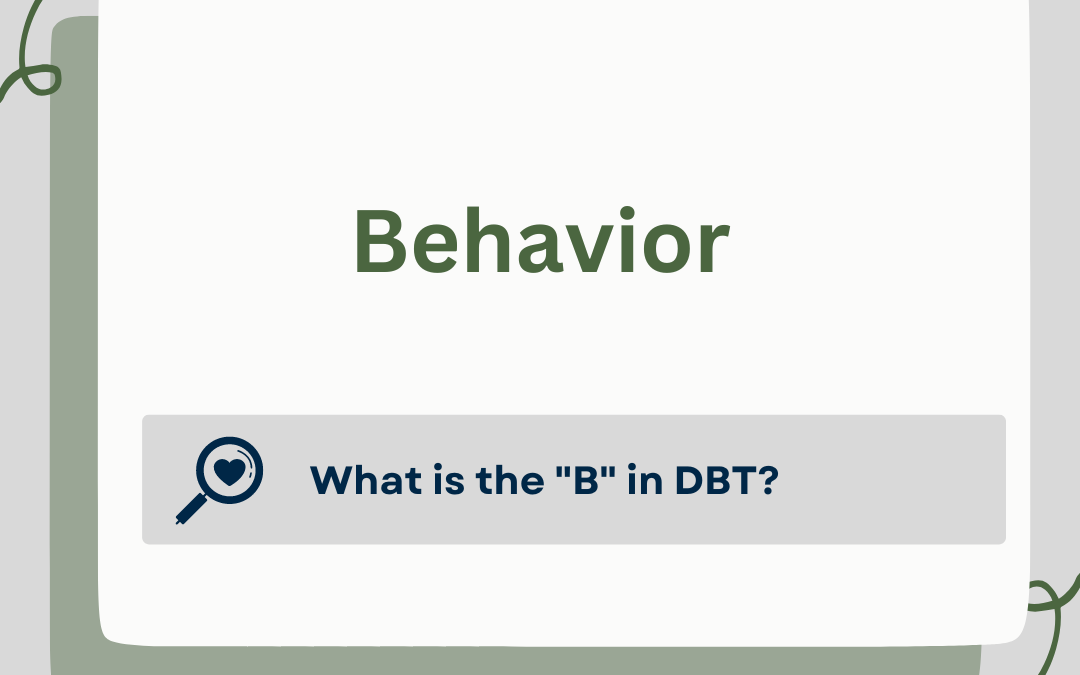Behavioral Targets in DBT
February 2023
To be human is to develop behaviors that steer us off course of the type of life we’d like to be living. Screen time, spending time in bed, or unhelpfully using alcohol or other substances are just a few examples of behaviors that might keep us stuck in a place that doesn’t feel good. The other side to unhelpful behaviors is that we might be finding it difficult to engage in the types of things that we’d actually like to be doing and would help us move towards a valued life. Taking care of our health, our home, and our relationships can all suffer when less helpful behaviors take us out of balance. By identifying behavioral targets in DBT, we can work towards increasing valued behaviors and decreasing unhelpful ones.
DBT doesn’t judge. In fact, this therapy is based on the assumption that our behaviors make perfect sense given our unique combination of biology, learning history, environmental factors, and current thinking. This being said, the D in DBT (dialectics) holds up the “and;” that even though our behaviors make perfect sense, we can do better and work towards change.
Behaviorism helps us aid in this change and indeed step number one is identifying behavioral targets in DBT. These targets are the things we would like to decrease (think screen time or unhelpful amount of time in bed) or increase (increasing self-care time or taking care of a valued project).
DBT prioritizes behavioral targets into Levels. Level 1 behaviors include suicidal or self-harming behaviors. These are the first targets in treatment as DBT argues we must cease reinforcing these life-threatening behaviors and begin giving DBT skills a chance to change our lives and first and foremost, keep our lives. Speaking of skills, Level 2 behaviors are “therapy-interfering behaviors” also known as TIBS, which are behaviors such as missing sessions, not completing therapy homework, not being forthright with your therapist, or not practicing skills. The final level of behaviors, Level 3 behaviors, are quality of life interfering behaviors: the things that we are doing too much of (screen time) or the things we would like to be doing more of (daily hygiene and movement).
As therapy begins, you and your therapist will develop behavioral targets in DBT. Next, you will work through each level of behavior using a behavioral chain analysis, a helpful tool that helps us identify events that prompt the behavior alongside maintaining factors such as thoughts, physiological cues, environmental factors, emotions, and other behaviors. As you progress through therapy, you and your therapist will identify patterns and specific links that maintain unhelpful behaviors.
Using the analogy of setting up dominoes in a line, every behavior is a sequence of dominoes that lead to a behavior happening or not happening. Behavioral chain analysis helps us identify these dominoes or “links” to first create clarity on what is happening and then, to replace ineffective links with more effective thoughts and behaviors. Replacing ineffective links with effective links is called a “solution analysis.” DBT skills groups work to teach participants effective skills so that when in individual therapy, you and your therapist can work on tailoring the skills to your unique situation and begin to live a life worth living.
Example Behavioral Chain Analysis:
Level 3 Target Behavior: spending 2 hours in bed past the point of waking up
- Prompting event: alarm goes off at 8am
- Thought- It’s too early; I might need to sleep more
- Body sensation- heavy eyes, sleepy body
- Thought- what am I going to do today?
- Emotion- anxiety
- Body sensation- tightness in chest
- Action- pickup phone and begin to scroll social media
- Thought- everybody is so active in the morning, what is wrong with me?
- Emotion- shame, anxiety
- Thought- I don’t think I have it in me to get up
- Action- continue screen time in bed until I have to get up to pee
- Consequences: feeling sadness and shame throughout my day, not attending to valued activities, which in turn, continues the unhelpful cycle of low mood and related behaviors of staying in bed and avoiding
Example Solution Analysis:
- Thought- it’s too early; check the facts- I have woken up at 8am before and had an effective day
- Body sensation- heavy eyes, sleepy body; check the facts/ self-validation– it makes sense to feel sleepy when waking up; I’m a human!
- Thought- what am I going to do today?; ABC PLEASE SKILLS– I have a made a plan with my therapist of how I can spend the first hour of my day to be more effective, I’m going to use OPPOSITE ACTION to get out of bed and go for my 10 minute walk- I’m working towards walking 30 minutes every morning and I feel better when doing it. Also, part of effective sleeping is getting up and getting up will help my sleep routine.
- Emotion- anxiety; opposite action- my therapist and I have reviewed how staying in bed makes my anxiety worse, I will act opposite the urge to stay in bed and engage in movement which will lessen my anxiety.
- Body sensation- tightness in chest; opposite action (see above); Distress Tolerance toolkit- my therapist and I have put together a kit of things I can do to help me move through anxiety effectively. I can enjoy some of my favorite scents in a diffuser or color to help move through my anxiety effectively. These actions are also building mastery towards an effective morning routine.
- Action- pickup phone and begin to scroll social media; changing the environment/ stimulus control- my therapist and I have discussed plugging my phone in outside of my room to limit the temptation of being on it in bed. Playing the tape through- scrolling through social media in bed generally ends with my feeling worse and I don’t like that feeling!
- Thought- everybody is so active in the morning, what is wrong with me?; check the facts- social media is highly curated; that being said check the facts: my emotions are giving me data that I might feel better if I get up and do something towards my values
- Emotion- shame, anxiety; check the facts: my emotions are giving me data that I might feel better if I get up and do something towards my values
While not every link may have a specific solution, by identifying several interventions in the chain, we can collaboratively work towards dismantling the links that lead to this behavior. With consistent practice, unhelpful links are replaced with skillful options. Something that seems confusing or hard to tackle becomes bite-sized and piece-by-piece, we are working towards a life worth living. By identifying behavioral targets in DBT, we are taking the first step towards understanding our actions and moving towards a valued life.

